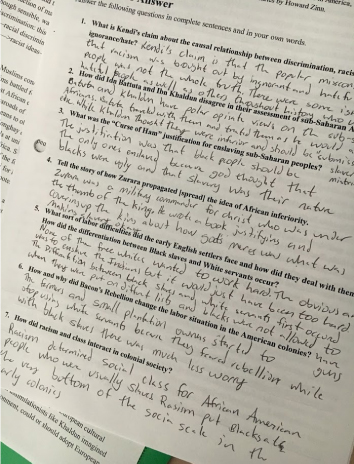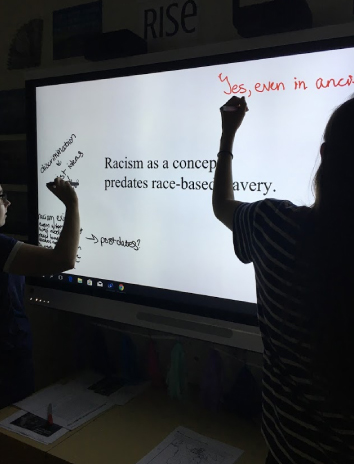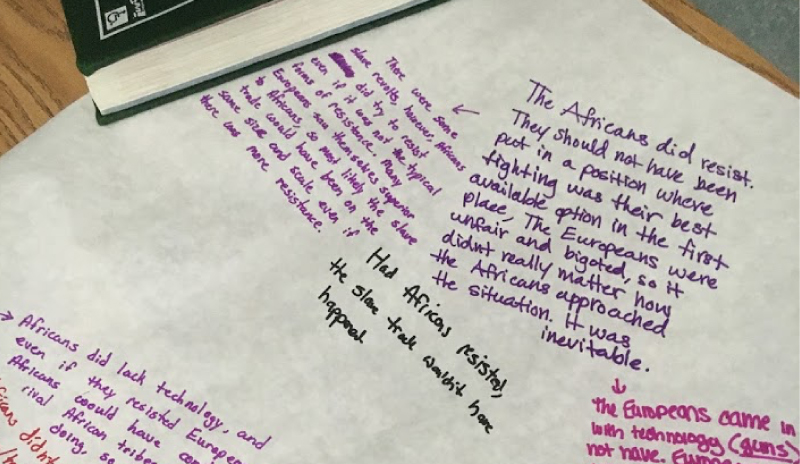I recently conducted my first “silent conversation” with my AP U.S. History classes. I’d seen the idea in several locations previously, however, I couldn’t yet conceptualize how it would work with my classes. Then, I saw a version posted by Caleb Lagerwey, a fellow APUSH teacher. His version of the silent conversation seemed perfect for the AP classroom, and it was a perfect way to try out the idea. (If you’d like to check out the documents and the lesson yourself, you can find them here.)
What is a “Silent Conversation?”

A silent conversation involves having students respond to ideas and to each other through writing. Before the conversation day, students read three articles relating to the topic they would discuss. Each of these articles were secondary sources from historians, and they were related to the development of race-based slavery. Some students read one set of articles, while other students read a different set. Each set included a series of questions the students answered. I gave students the week to read the articles and answer the questions. They agreed that this was a very reasonable time frame.
In this case, provocative prompts relating to the development of race-based slavery were placed on poster board and displayed around the classroom. I pointed out to the students that I didn’t necessarily agree with any of the prompts – they were just ideas meant to encourage conversation. Students took turns visiting each of the prompts and writing their own reflections. Students were encouraged not to speak, and to add their thoughts to the poster board instead.

I really liked this method of conversation for several reasons. For one, students were able to take a breath, and think about their response before they added to the poster board. As a result, the comments made were really insightful and thoughtful. Secondly, as the comments were silent, every student had a chance to participate. I have some really quiet students, and I loved seeing inside their ideas. Finally, the prompts really went beyond the history. Students were able to make connections to their understandings of race and racism in general. I have very small classes, so the process took about 30 minutes. I do wish that my classes were slightly larger, as some of the ideas made in one class would have connected well with ideas brought up in the second.
At the end of class, I discussed some of the comments I had seen students make. Then, we watched the video “This is America,” and made connections. I would like to think more about how this portion of the lesson was conducted. Did the students get everything out of the process that they should have? What could have we done additionally that would have brought the experience to a satisfying conclusion? Honestly, I’m still processing this component.
I noted to my students that this process was really about thinking. If they thought about the information, that would connect to their memory and their understanding. They agreed with me that this was a valuable process.
Reflections
I hope to conduct more silent conversations in the future. The set up for this style of teaching can easily be varied. To prepare for the conversation, students might read primary sources instead, or a combination of primary and secondary sources. Students might respond to prompts from primary sources. A teacher could pick provocative quotes from primary sources for students to respond to. Or, there could be no prior reading required, and teachers could use the experience to assess students prior knowledge. The choices are really endless.
Have you conducted a “silent conversation” in your classes? Are you thinking about conducting one? What questions do you have?


4 Responses
I am a student teacher…going to try it!!!
I tried this with middle school SS my first year teaching using documents about the Holocaust. It was a big flop because some students didn’t take it seriously and wrote jokes on the papers instead. I like this idea of having them write it on the board instead to where it is more monitored. Thanks for the great post!
I would suggest providing them with more context before doing so. Middle schoolers need background infromation and some more guildelines before trying an activity of this sort. Also, I give them different color sharpies so I can monitor who wrote what.
I love doing these in my high school social studies classes! I work in an urban school with a lot of at risk students, so I’ve had to adjust my methods to fit their needs. We typically do them with topics they are interested in, such as government and what limits there should be (really interesting thoughts on police brutality!). I use chart paper and pose thought provoking questions on each. They go around once and respond with personal thoughts. Then the second time around I give them a “key” to follow such as, put a Star next to comments you agree with, write questions you have beneath comments, write a counter to a claim, etc. We then do one more round for final thoughts and reflection. They then go back to their seats for a class debrief. I love it! I do like your method of having them prep ahead of time. I could do something like this over multiple days I think. Thanks for the inspiration!